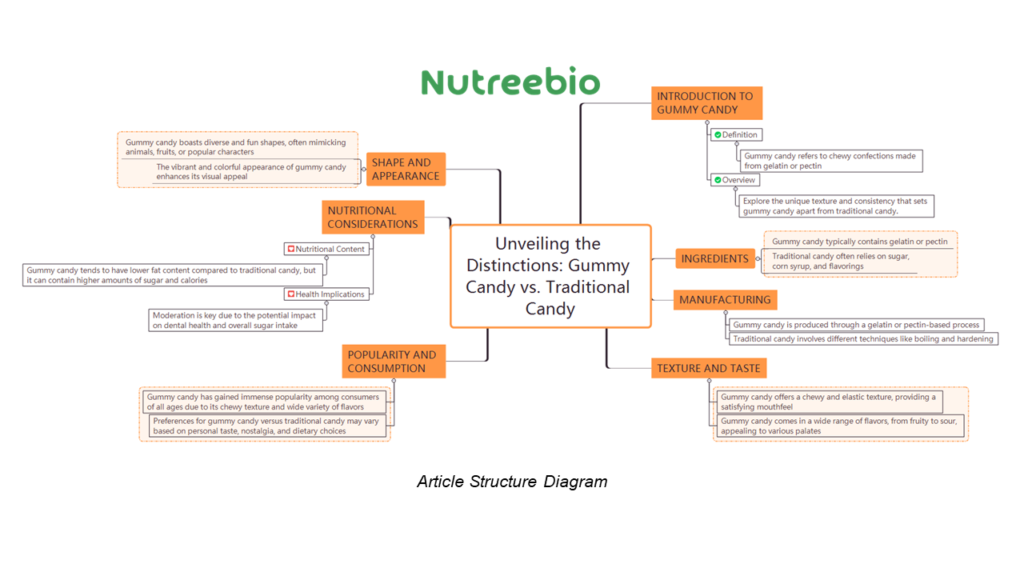Gummies and candies are popular treats enjoyed by people of all ages. While they may seem similar at first glance, there are distinct differences in their composition, texture, manufacturing process, flavor, packaging and nutrition that set them apart. In this blog post, we will explore the variations in ingredients between gummies and candies and delve into the unique texture and chewiness of gummies compared to the diverse range of textures found in candies.


1. Gummy vs Candy——Composition and Texture
Gummies and candies may fall under the umbrella of sweet treats, but they have notable differences in composition and texture. Gummies rely on gelatin to provide their unique chewy consistency, while candies encompass a broader range of textures depending on their specific ingredients and preparation methods. Understanding the distinctions between gummies and candies can enhance our appreciation for these delightful treats and help us make informed choices based on our personal preferences.
1.1 Main Difference in Ingredients between Gummy and Traditional Candy
The primary difference between gummies and candies lies in their ingredients. Gummies are typically made using gelatin, which gives them their characteristic chewy texture. Gelatin is derived from animal collagen and is responsible for the firm yet pliable consistency of gummies. It provides a unique mouthfeel and enhances the overall eating experience.
On the other hand, candies encompass a broader category of sweet treats that come in various forms, textures, and flavors. Candies can be made using different combinations of ingredients such as sugar, corn syrup, flavorings, colorings, and various additives. Unlike gummies, candies do not necessarily rely on gelatin for their texture and can have a wide range of consistencies, including hard, soft, sticky, or even crunchy.
1.2 Texture and Chewiness of Gummies compared to Variety of Textures Found in Candies
a. Gummies:
Gummies have a distinct texture that sets them apart from other candies. They possess a chewy and slightly bouncy consistency that allows them to be enjoyed slowly, savoring each bite. The gelatin in gummies provides elasticity, giving them a satisfying chew that many people enjoy. The texture of gummies is often described as soft, pliable, and easy to bite into. It is this unique chewiness that contributes to the appeal and popularity of gummy treats.
b. Candies:
Candies, on the other hand, come in a wide variety of textures. Some candies are hard, requiring a bit of time and effort to bite into, while others are soft and melt in the mouth. There are candies that are sticky and cling to the teeth, providing a longer-lasting chew. Additionally, certain candies have a crispy or crunchy texture, offering a contrast to the chewy nature of gummies. The range of textures found in candies is vast and can be attributed to the different ingredients and cooking processes involved.
Candies may also incorporate additional elements such as nuts, nougat, caramel, or crispy centers, further diversifying their textures. From hard candies that dissolve slowly to chewy taffies and creamy chocolates, the variety of textures in candies allows for a wide range of taste experiences.


2. Gummy vs Candy——Manufacturing Process
Gummies and candies are beloved treats enjoyed by people of all ages. While they share a common goal of satisfying our sweet tooth, there are distinct differences in their manufacturing processes. In this section, we will explore the specific manufacturing processes of gummies and candies, including the use of gelatin or other gelling agents in gummies, and the various techniques employed in candy production, such as boiling, cooling, and shaping.
a. Specific Manufacturing Process of Gummies
The manufacturing process of gummies involves several key steps that contribute to their unique texture and consistency. Here is a general overview of the process:
- Gelatin or Gelling Agent Preparation: The process begins with the preparation of gelatin or other gelling agents. Gelatin, derived from animal collagen, is the most common gelling agent used in gummy production. It is dissolved in water or fruit juice to create a gel-like substance.
- Heating and Mixing: The gelatin mixture is heated to dissolve it completely, creating a smooth and consistent liquid. At this stage, additional ingredients such as sweeteners, flavors, colors, and nutritional additives may be added to the mixture. The ingredients are thoroughly mixed to ensure even distribution.
- Molding and Cooling: The liquid mixture is poured into specialized molds in the desired shapes and sizes. The molds may be made of silicone or other food-grade materials. The filled molds are then cooled to allow the gelatin to set and solidify, transforming the liquid mixture into the chewy gummy texture.
- Demolding and Drying: Once the gummies have solidified, they are carefully removed from the molds. Excess moisture is removed through a drying process, which can be done through air drying or using specialized equipment. This step helps to enhance the shelf stability of the gummies and prevent stickiness.
- Finishing and Packaging: After drying, the gummies undergo a final inspection to ensure quality and uniformity. They are then ready for finishing touches such as polishing or sugar coating, which can add an extra layer of texture and visual appeal. Finally, the gummies are packaged in airtight containers or sealed pouches to maintain freshness and extend their shelf life.
b. Different Techniques Used in Candy Production
Candy production encompasses a wide range of techniques, depending on the type of candy being made. Here are some common techniques employed in candy manufacturing:
- Boiling: Boiling is a fundamental technique used in candy production. Sugar, along with other ingredients such as corn syrup, water, and flavorings, is heated to high temperatures to create a syrup. The syrup is boiled until it reaches the desired consistency, which varies depending on the type of candy being produced.
- Cooling and Shaping: After boiling, the candy syrup is cooled to a manageable temperature. It is then shaped using various methods, such as pouring into molds, pulling and stretching, rolling, cutting, or forming into individual pieces by hand or machine. Different candies require specific shaping techniques to achieve their unique forms.
- Hardening and Finishing: Once the candy is shaped, it undergoes a hardening process to solidify and stabilize its structure. This can involve cooling at room temperature or in a controlled environment, such as a refrigeration unit or cooling tunnel. After hardening, the candies may be polished, coated with sugar or other confectionery coatings, and packaged for distribution.
- Confectionery Techniques: Beyond the basic techniques, candy production may involve additional confectionery techniques. These include processes like enrobing (coating with chocolate), panning (layering candies with multiple coatings), caramelizing, nougat-making, or incorporating nuts, fruits, or other inclusions into the candy matrix.
The manufacturing processes of gummies and candies differ in their approach to achieving the desired textures and consistencies. Gummy production involves the use of gelatin or other gelling agents, heating, mixing, molding, cooling, demolding, drying, and finishing. On the other hand, candy production employs techniques such as boiling, cooling, shaping, hardening, and various confectionery processes. Understanding the distinct manufacturing processes of gummies and candies provides insights into the craftsmanship and artistry behind these delectable treats. Whether you enjoy the chewy delight of gummies or the diverse range of candies, both offer a world of sweetness to indulge in.


3. Gummy vs Candy——Flavor and Variety
Apart from their distinct manufacturing processes, these confectioneries also differ significantly in terms of flavor and variety. In this blog post, we will explore the wide range of flavors available in gummies, including fruit flavors and novelty options, as well as the vast assortment of flavors and forms found in candies, such as hard candies, chocolates, and chewy candies.
a. Wide Range of Flavors in Gummies
One of the delightful aspects of gummies is the abundance of flavors available. Gummies come in an array of fruit flavors, capturing the essence of various fruits like strawberry, orange, cherry, raspberry, lemon, and many more. These fruity flavors contribute to the refreshing and vibrant taste experience that gummies offer. From sweet and tangy to sour and tart, the diversity of fruit flavors in gummies allows for a wide range of preferences to be satisfied.
In addition to traditional fruit flavors, gummies also offer a world of novelty options. Manufacturers have creatively expanded the flavor profile to include unique and playful variations. Some popular novelty gummy flavors include cola, bubblegum, cotton candy, watermelon, green apple, and even flavors inspired by popular beverages or desserts. These novelty gummy flavors add an element of fun and excitement to the gummy-eating experience.
b. Vast Assortment of Flavors and Forms in Candies
Candies, as a broader category, encompass a vast assortment of flavors and forms that cater to various taste preferences. Let's explore some of the common types of candies and their unique flavor profiles:
- Hard Candies: Hard candies are known for their long-lasting and intense flavors. They come in a wide range of fruit flavors like cherry, lemon, orange, lime, and grape. Hard candies often feature bold and vibrant flavors that deliver a burst of sweetness when savored or dissolved slowly.
- Chocolates: Chocolates, a beloved type of candy, offer a rich and indulgent flavor experience. From creamy milk chocolate to decadent dark chocolate, chocolates can be enjoyed plain or filled with various centers like caramel, nougat, nuts, or fruit fillings. Chocolates provide a diverse range of flavor profiles, from sweet and creamy to bittersweet and complex.
- Chewy Candies: Chewy candies, including caramels, taffies, and chews, provide a delightful and prolonged chewing experience. They come in a multitude of flavors such as vanilla, caramel, butterscotch, licorice, and fruity options like strawberry, raspberry, and watermelon. The chewiness of these candies allows for a gradual release of flavors, making them both enjoyable and satisfying.
- Sour Candies: Sour candies have gained popularity for their tangy and puckering flavors. They offer a unique taste experience with a combination of sweetness and acidity. Flavors like sour apple, lemon, cherry, and watermelon are common in sour candies, creating a zingy and exciting sensation on the taste buds.
- Gourmet and Artisanal Candies: The world of candies also encompasses gourmet and artisanal creations. These candies often feature innovative and sophisticated flavor combinations. Examples include exotic fruit flavors, floral notes, herbal infusions, and even savory-sweet fusions. Gourmet and artisanal candies provide a premium taste experience for those seeking something unique and extraordinary.
Gummies and candies differ not only in their manufacturing processes but also in the flavor and variety they offer. Gummies boast a wide range of fruit flavors, along with novelty options that add a touch of whimsy to the experience. On the other hand, candies encompass a vast assortment of flavors and forms, including hard candies, chocolates, chewy candies, sour candies, and gourmet creations. Whether you prefer the juicy and playful flavors of gummies or the diverse taste profiles found in candies, both provide a delightful array of options to satisfy your sweet cravings.


4. Nutritional Benefits of Gummies:
The fourth and most important difference between gummy and candy is the difference in benefits and nutrition. Gummies and candies are popular sweet treats enjoyed by people of all ages. While both offer a delightful taste experience, there are notable differences in the benefits they provide, particularly regarding their nutritional value. In this blog post, we will delve into the unique benefits of gummies, focusing on their nutritional content and how they differ from traditional candies.
Gummies, unlike regular candies, offer several nutritional advantages that make them a favorable choice for those seeking a sweet treat with added benefits. Let's explore some of the key nutritional benefits of gummies:
a. Vitamins and Minerals
One of the primary advantages of gummies is their potential to deliver essential vitamins and minerals in an enjoyable format. Gummy supplements are available in various formulations, including multivitamins, which provide a convenient way to supplement your diet with key nutrients. These gummies are typically fortified with vitamins such as vitamin C, vitamin D, vitamin B12, and minerals like calcium and zinc. They offer a tasty alternative to traditional vitamin pills, making it easier for individuals, especially children, to meet their nutritional needs.
b. Dietary Fiber
Certain gummies, particularly those made with natural fruit extracts, can be a source of dietary fiber. Fiber plays a crucial role in supporting digestive health, promoting satiety, and regulating blood sugar levels. Gummies made with fiber-rich ingredients like pectin or soluble fiber provide an enjoyable way to incorporate this essential nutrient into your diet.
c. Antioxidants
Gummies infused with antioxidants can offer additional health benefits. Antioxidants help combat free radicals in the body, which can contribute to cellular damage and oxidative stress. Gummies enriched with antioxidant-rich ingredients like berries, citrus fruits, or green tea extracts provide a delicious way to boost your antioxidant intake and support overall well-being.
d. Plant Extracts and Superfoods
Many gummy formulations incorporate plant extracts and superfoods known for their potential health benefits. These can include ingredients like turmeric, ginger, elderberry, or echinacea, which are renowned for their immune-boosting properties. Gummies containing these natural extracts offer a convenient and enjoyable way to incorporate these beneficial substances into your daily routine.
e. Hydration and Electrolytes
Gummies formulated with electrolytes can be an excellent option for replenishing fluids and minerals lost during physical activity or hot weather. These gummies typically contain ingredients like potassium, sodium, and magnesium, which play a vital role in maintaining proper hydration and supporting optimal muscle function.
It's important to note that the nutritional benefits of gummies can vary depending on the specific product and brand. Reading the labels and choosing high-quality gummy supplements or those made with natural ingredients will help ensure you receive the maximum nutritional value.
In conclusion, as a convenient and enjoyable way to supplement our diets with essential vitamins, minerals, and nutrients. Gummy supplements can support various aspects of health, including immune function, bone strength, and cognitive health. Additionally, gummies made with natural ingredients like fruit extracts may contain antioxidants that help combat free radicals and promote overall well-being. The appealing taste and texture of gummies also enhance compliance, making it easier to incorporate important nutrients into our daily routine.
5. Conclusion
Gummies offer unique nutritional benefits compared to traditional candies. With their potential to deliver essential vitamins, minerals, dietary fiber, antioxidants, and other beneficial ingredients, gummies can provide a tasty way to supplement your diet and support overall well-being. Whether you're seeking a convenient multivitamin option, a fiber-rich snack, or a boost of antioxidants, gummies offer a delicious and enjoyable solution. However, it's essential to choose high-quality gummy products that prioritize natural ingredients and nutritional value to reap the maximum benefits they offer. So, the next time you crave a sweet treat, consider reaching for a gummy that not only satisfies your taste buds but also provides a dose of nutritional goodness.


